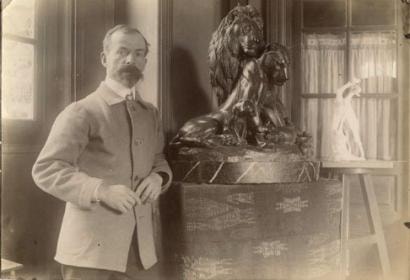
Georges GARDET
A student of Aimé Millet at the École des Arts Décoratifs, Georges Gardet also received advice from Frémiet, who was a strong influence on him. Gardet quickly revealed himself to be a talented animalier sculptor.
At age 24, he had his first big success with Drame au Désert, a plaster sculpture exhibited at the Salon of 1887, a bronze version of which was commissioned for the Parc Montsouris, where it still stands. Gardet quickly imposed himself as a great classic animalier in the style of Barye and Frémiet, which earned him numerous commissions, especially from the state. He sculpted the Chien Danois and Chienne Danoise (Great Danes), two marbles for the grand staircase at the Chantilly chateau in 1894. He also sculpted Tigre et Lion, a monumental marble group for the Vaux-le-Vicomte chateau in 1898; the lions that decorate the stairs of the Pont Alexandre III on the right bank of Paris in 1900; and two large lions for the Laeken palace in Brussels. Gardet also specialized in sculptures carved from multicolored marble and other precious materials, whose particularities he exploited ably. These precious objects would catch the eye of the grand prize juries of the Automobile Club or the Jockey Club, who awarded him many prizes.
In 1918, Gardet was the first strictly animalier sculptor to be elected to the Académie des Beaux-Arts. He was also named Knight of the Legion of Honor in 1898, then Officer in 1900, and won the grand prize at the Exposition Universelle of 1900 for two large groups, Lions and Lionnes destined for the Vaux-le-Vicomte chateau.
After the war of 1914-1918, Gardet’s star began to pale in comparison to more modern artistes.

